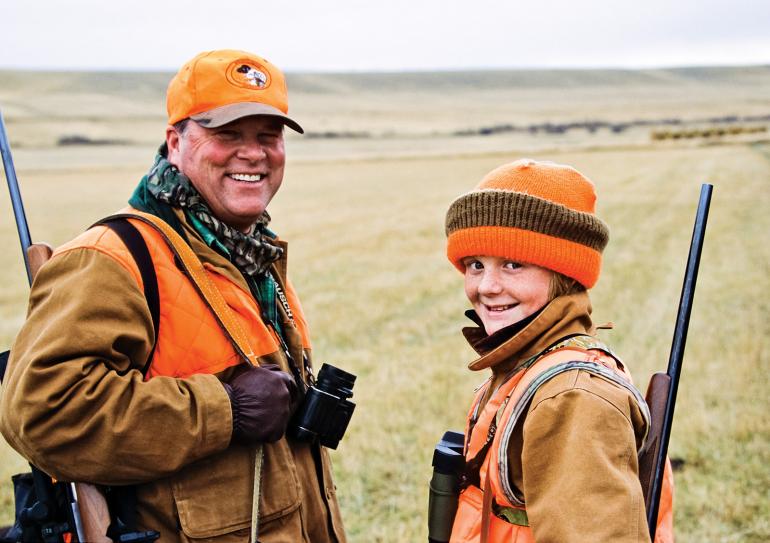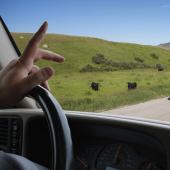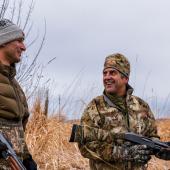Straight Shooting
Etiquette to bring afield.
There are ethical codes for just about everything we do in life. Be it playing poker, walking the dog, or running the river, there is proper and improper form. In hunting, we engage in a predator-prey relationship with a living animal with the objective to take its life. The moral standard for how we conduct ourselves throughout this process could not be higher.
It should be noted that hunting would not be possible if it weren’t for healthy and sustainable wildlife populations. Wildlife need habitat offering food, shelter, water, and protection from predators. Without all these ingredients, there is no game to be played. Each hunter should have this in the back of his or her mind when preparing for a hunt, while afield, and after pulling the trigger.
If you’re just starting out, a good way to cultivate an ethical background is by first observing animals without a weapon. Watch their behavior patterns, learn their habitat, understand them as living beings. The current trajectory of our society increasingly shelters humans from the natural environment, further separating us from our animal brethren. To buck this trend, I recommend going out for long periods of time without digitized technology, day and night, until you begin to feel like you’re a living part of the ecosystem.
Once you’ve established a sincere respect for the land, water, and animal you intend to pursue, see to the duty of a clean and ethical kill. The way you achieve this is practice and familiarity. Develop a deep understanding of your weapon well before the season and spend time using it safely. Sight it in using a solid rest and then practice as you would in the field (different positions, various distances, elevated heart rate, etc.).
You’ll find that when a bull elk is in your crosshairs—even if you objectively know it’s too far or that his vitals aren’t fully exposed—it’s easy to convince yourself otherwise.
Ammunition used to be strictly lead, both for shotguns and rifles. However, this metal is poisonous for animals that consume carrion. Whenever possible, use copper bullets for rifles and steel shot for shotguns. It’s required by law to use steel for migratory birds, so make it easy on yourself—and the wildlife—and use it for upland birds, too.
When you go afield, you take on a myriad of responsibilities, some of which will take years to fully understand. You have an obligation to know land ownership, bag limits, shooting hours, hunting districts, and species types. Going with a mentor or someone with experience will help expedite this knowledge. The firm laws can all be found in the regulations, which can change from year to year. Pick up new copies every season.
Hunting can take a ton of work, and many efforts go without payout. Sometimes, it takes a full season to get within range of a legal animal. But when an opportunity presents itself after tremendous preparation and effort, the pressure and excitement can be overwhelming. This scenario presents an ethical challenge. You’ll find that when a bull elk is in your crosshairs—even if you objectively know it’s too far or that his vitals aren’t fully exposed—it’s easy to convince yourself otherwise. It’s your job to maintain discipline in these situations and to not let excitement turn to bloodlust, leading to an irreversible mistake. It can be a mental battle, but even if you don’t end up pulling the trigger, making the right choice feels better in the long run.
If you hunt long enough, you will eventually wound an animal. Tragic as it is, it’s inevitable. This is one of the toughest parts of hunting, but when it happens, you must follow through. Devote your entire attention to finding that animal—blood-trail, grid, bring a dog back to the scene. Do everything in your power to honor the animal that you may have killed, and at the end of the day, recognize where you went wrong, so you can correct it for the next time.
Part of the hunter’s job is to be humble, courteous, and respectful—both in and out of the field. Be conscious of your behavior. Just because you think you look cool in your blood-stained camo doesn’t mean you should show up to the bar or grocery store in it. More often than not, non-hunters consider that crass—and they’re right. Carry yourself in a way that paints hunters in a positive light, not a negative one. If you must take bloody grip-and-grin photos, share them with your hunting buddies, not the worldwide web.
One of the biggest lessons hunting has taught me is to approach it with the beginner’s mind. The natural world and its animals have things to teach you, and no one knows it all. Even those who fill their tags every year have lessons to learn and areas in which they can improve. Put in the work, honor the animal, and be open to what the wild offers. The rewards are immense.
For more hunter ethics, read Beyond Fair Chase by the late, great Jim Posewitz. Another great resource is Hunt Kind, which operates in coordination with One Montana’s "Master Hunter" program. The application period for the 2023 class begins October 1.















